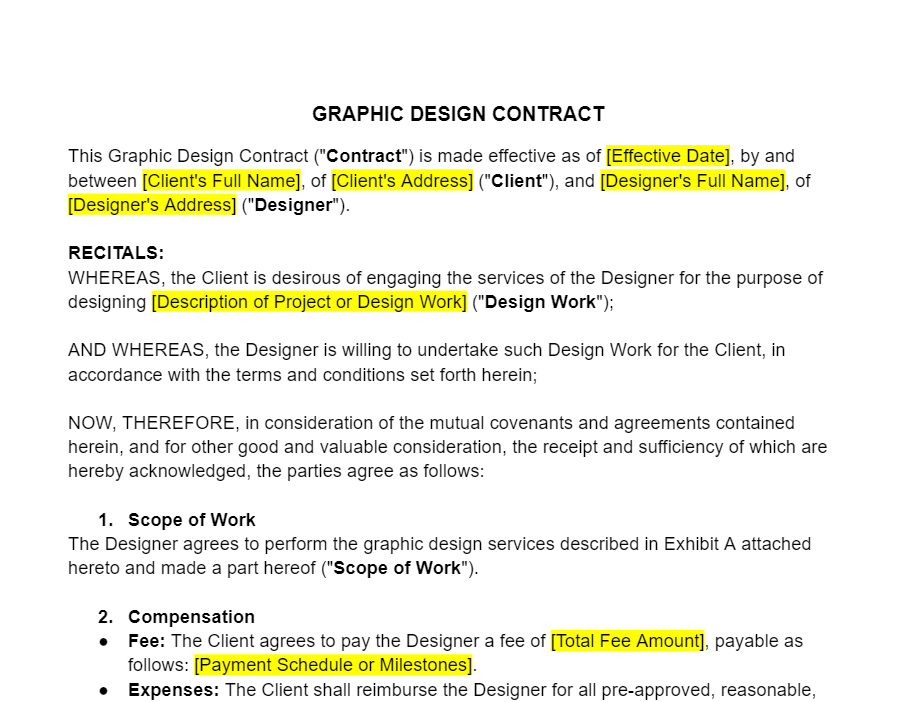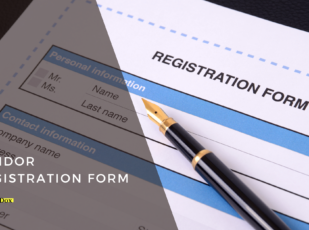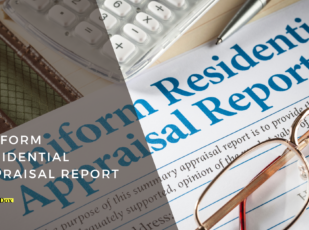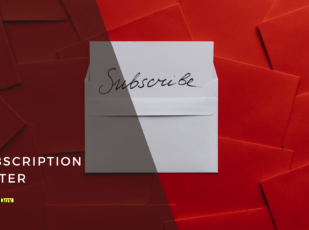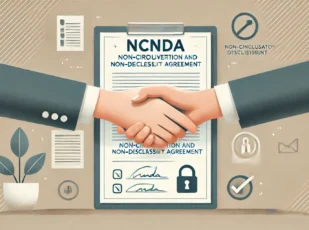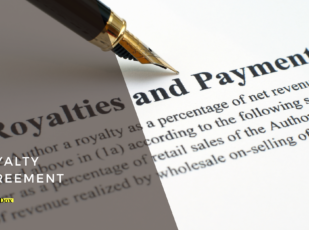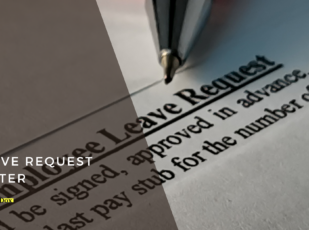
Graphic Design Contract Template
11 Downloads
Commercial, Employment
February 17, 2025
Sayantani Dutta
Creative services rely on clear and mutually beneficial agreements between graphic designers and their clients. There are a lot of considerations that go into a graphic design project. If there is no comprehensive agreement underlying the project, both the client and the graphic designer can suffer a lot of setbacks such as delays and feedback loops that slow down the progress of the work.
For clear deliverables, it is important to have clear standards, terms, and specifications of what is required. If there is a need for additional references, for example, to get the ideal output, then that should be stipulated in the agreement. If the client requires the deliverables with certain warranties beyond the usual intellectual property rights, such as raw files and additional support in special cases, then those also need to be clarified.
Long story short, the Graphic Design Contract is a legal document that outlines the scope of work, timelines, compensation, rights to the artwork, and other key terms of the project. It has all the details and specifics to ensure that both parties have a shared understanding of the project’s expectations for a productive and harmonious working relationship.
Clients and graphic designers who lack the necessary experience will often find themselves stuck in loops.
For example, on the client side, having multiple approvers creates a lot of problems because creative work is subjective, and everyone’s opinions vary. In this case, the graphic designer needs solid protections in the agreement specifying the number of revisions or additional charges for revisions beyond the set number to make sure the client respects the time and effort of the designer.
On the other hand, when you are hiring a graphic designer for a specific task, you need to be explicit about the expectations in terms of quality. If the designer overpromises then underdelivers, it wastes a lot of time in correcting the output. For this, the agreement needs to specify the correct standards and how the output will be judged—let’s say with references or examples—so the designer knows what is expected of them. This way, they will not be sending lower-quality deliverables your way to take up more of your time.
All of these are important considerations and the entire agreement is responsible for clearly outlining these conditions and clauses when contracting graphic design services from an independent contractor or an agency for some design work. The Graphic Design Contract is a legally binding document that additionally offers protection for IP and confidential information and other disclaimers such as limitation of liability and termination clauses under the governing law.
In this article, we are going to look at the importance of a solid contract and the risks of relying on an insufficient one. We will also cover the essentials that such a contract is supposed to have and introduce you to our very own Graphic Design Contract Template—100% customizable to fit your needs!
Importance of a Freelance Graphic Design Contract
The Graphic Design Contract is important for several reasons. First of all, it formalizes the relationship between the designer and the client, offering a legal framework that protects the interests and rights of both parties. But more importantly, the contract has terms and clauses that clarify a lot of things. Without these clarifications, both sides stand to lose precious time or waste their effort in communication, revisions, or other activities. That is why this legally binding agreement has to be comprehensive to cover all bases, not just the scope of work and its timelines.
For designers, a good Graphic Design Contract clarifies the project’s scope, deliverables, and compensation. This prevents scope creep and ensures fair payment for their work. And for the clients, it offers assurance regarding the delivery timeline, the quality of work, and the terms under which they can use the final designs.
Furthermore, a well-crafted Graphic Design Contract also helps prevent misunderstandings and disputes as it states the terms of the collaboration clearly. Ultimately, it helps save time and resources that might otherwise be spent on resolving conflicts.
The singular objective of this agreement is to streamline the project upfront. From how client approval is to be provided to what quality is expected from the designer, it covers all bases to avoid ambiguities and wasted time/effort on both sides. Whether it is a small business or a large company, you are always better off having a comprehensive Graphic Design Contract underlying any creative graphic design work.
The Risks of Using Insufficient or No Graphic Design Agreement
Understandably, not everyone cares about comprehensiveness. Businesses often contract graphic designers (or graphic designers sign agreements with clients) that are very boilerplate and generic. They cover the basics such as what is to be done (project description or scope of work), delivery timelines, payment terms, and a few other sections. Relying on this can open you up to severe consequences.
Such a situation will expose both designers and clients to significant risks—financial and legal. Without a formal agreement, it is not rare for expectations regarding project scope, timelines, and payment terms to become misaligned, thus leading to dissatisfaction and potential disputes that waste everyone’s time (and can get quite expensive in some cases).
Designers often face delayed payments or additional work beyond the initially agreed-upon scope without compensation in these cases. Clients, on the other hand, can encounter issues with the quality or delivery of the work, or confusion over the usage rights of the designs.
The design proposal can be for anything—branding work, packaging/label design, social media assets, web design, or digital artwork, for example. All of these become less efficient and slower when these problems arise (the client not providing correct feedback or the designer unable to meet quality standards, for example).
And let’s not forget that the absence of a contract also complicates legal recourse for both parties in the event of a breach of agreement. That is why you are highly recommended to stick to a premium, well-drafted Graphic Design Agreement, and avoid free templates or generic free graphic design contracts.
Graphic Design Contract: Key Components
Alright, so with all that out of the way, it is now time to take a look at what makes the ideal Graphic Design Contract.
Depending on the nature of the work, the exact clauses will differ from project to project. Graphic design is a huge domain and the specifics of UI design, for example, might include considerations that are not present in, let’s say, packaging design. In UI design, the designer is responsible for testing and prototyping. In packaging design, instead of that, the designer is responsible for ensuring things such as adherence to KLDs and leaving proper bleeds as per the printer’s directions.
As such, it is hard to pin down exactly what clauses and conditions your contract will contain. But that does not mean we cannot give you the broad topics that will cover all bases. For example, KLD adherence or UI prototyping are both part of the scope of work itself, which is a broad category that the contract will have.
With that in mind, here are the sections that most Graphic Design Contracts include:
- Parties Involved: First of all, the contract will specify who the parties are. This includes the proper identification of the designer or contractor and the client, including their legal names and contact information.
- Scope of Work: The scope of work section offers a detailed description of the design services to be provided, project deliverables, and any specific client requirements. The exact deliverables will depend on the nature of the work or the workflow that the designer has, but the client has to specify the items that need to be delivered for final use.
- Timeline: Pretty straightforward—all clauses regarding the timeline in which the designer has to finish the project go here. It is a good practice to break down the entire scope or final deliverables into milestones—such as initial drafts, mockups, prototypes, etc. and assign turnaround times for all of these milestones to better manage the project.
- Compensation: The compensation section includes the payment terms including the hourly rate, invoicing schedule, and any upfront deposits or retainer fees that are agreed upon. The design business can be a little ambiguous. For example, when a business hires a programmer to develop a tool or a writer to publish a few blog articles, the output is often black and white—acceptable or not. In design, the gray area is considerably larger, with clients often taking the designer through several feedback loops and arriving nowhere even after many rounds of iterations, sometimes even going dangerously close to the diverging point earlier in the project lifecycle itself. This is why the designer might want to have additional compensation terms for revisions beyond a particular time or count. These clauses also go in this section.
- Revisions & Approvals: Next, the Graphic Design Contract will offer guidelines for the revision process, including the number of included revisions and the process for requesting additional changes.
- Rights & Ownership: It is important to make sure that all creative output such as artwork or branding is the property of the client, not the designer. When a designer creates something, the output is automatically protected by copyright laws. It is a creative output and the designer does not need to file any document to get its ownership. As such, by default, the IP rights of the generated output remain with the designer, unless the ownership is transferred. That is where the rights and ownership section comes into the picture. It clearly specifies that all work created during the project timeline is the sole property of the client. At the very least, include a clear stipulation of the rights transfer for the completed designs, usage rights for both parties, and any restrictions that are relevant to your case.
- Confidentiality: The client will often need to share confidential and proprietary information or intellectual property with the designer for the project’s requirements. This can include the company brand guidelines, competitor research, market analysis, internal documentation, trademarks, etc. The confidentiality section includes provisions to protect all this from misuse or unsolicited use. A separate NDA might be required as well.
As this is a legal contract, it will also include sections on termination (conditions under which the contract can be terminated by either party and the consequences of termination), dispute resolution (the mechanisms for addressing disagreements or disputes arising from the contract), and the governing law (the legal jurisdiction that governs the contract and resolution of disputes), before concluding with the signs or e-signs of both parties.
Better Graphic Design Contracts with FreshDox.com
We can help graphic designers and their clients in creating successful, transparent collaborations. FreshDox.com offers a professionally designed Graphic Design Contract Template developed by legal experts familiar with the specific nuances of creative service arrangements that offer a customizable and comprehensive framework for creating clear and enforceable contracts.
Our template is easy to customize—just add, remove, or edit clauses and sections from readymade terms depending on the nature of the work. When you subscribe to FreshDox.com, you gain access to our Graphic Design Contract alongside a host of other legal and professional document templates that you can freely customize and download in Word and PDF formats!
FreshDox.com also has a 14-day trial period for new users. When you sign up for our trial, you can enjoy the perks of both our membership plans—Basic and Premium. Basic Members can download up to three document templates a month whereas Premium Members enjoy unlimited downloads. If you are a graphic designer, a design agency, or an organization that regularly hires designers or agencies, you have come to the right place! Quickly draft different types of Graphic Design Contracts for different types of projects while keeping your standard policies and conditions consistent across all agreements!
With our Graphic Design Contract Template, you have the confidence to start your creative projects knowing that the terms of your collaboration are clearly defined and protected. So, wait no more! Sign up today to improve your project management and safeguard your creative endeavors with FreshDox.com!
Related Templates
Discover more templates that align with your needs and preferences.

Ready to Sign Up?
Sign up for FreshDox.com’s 7-day trial and discover why so many individuals and businesses trust us for their legal document template needs.
- Cancel any time
- 7-day free trial
- From 300+ Customer Reviews

